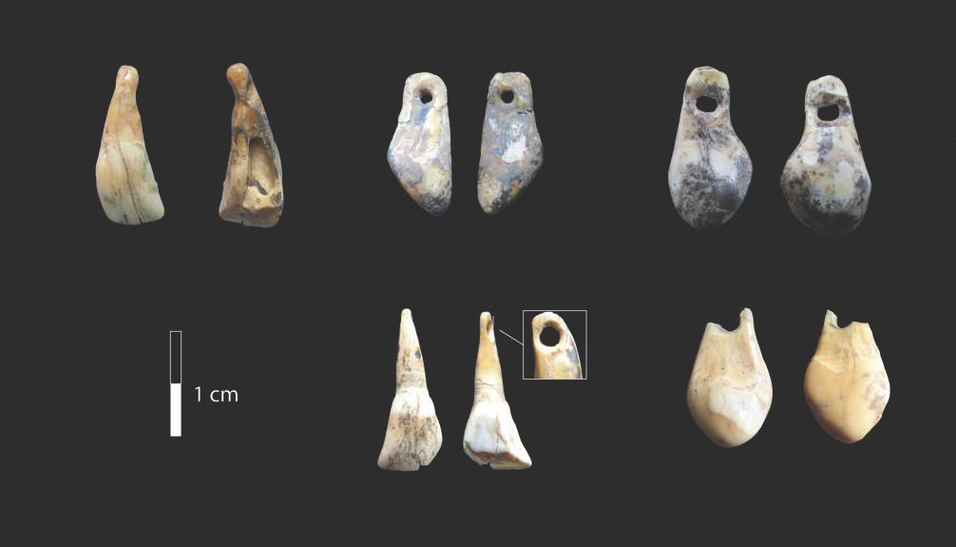An international team of researchers, including Associate Prof. Katerina Douka (Department of Evolutionary Anthropology) and led by the Max Planck Institute for Evolutionary Anthropology (MPI-EVA) in Leipzig, Germany, have retrieved and sequenced the DNA of a female individual who touched, manufactured and/or wore a pierced deer tooth 20,000 years ago. The ornament comes from the key Paleolithic site of Denisova Cave in southern Siberia, Russia, where previously researchers have identified the physical remains of Denisovans, Neanderthals as well as the presence of early modern humans in DNA from the cave’s sediment. The new study reports the first successful isolation of human DNA from the surface of an artefact deriving from the ancient human who last touched and handled it.
Denisova Cave in the Altai Mountains of southern Siberia in Russia rose to fame 13 years ago when a fossil pinky bone from the site was genetically sequenced, revealing that it belonged to a new, previously unknown human group. The group has been called – Denisovans, after the site. Since then, Denisova Cave has also revealed evidence for Neanderthals, their easternmost distribution so far, as well of early modern humans who arrived at the site ~50,000 years ago or shortly after. Excavations undertaken over the past 40 years led by archaeologists from the Institute of Archaeology and Ethnography (Siberian Branch of the Russian Academy of Sciences; IAET SB RAS) in Novosibirsk, Russia, revealed the longest archaeological sequence of northern Eurasia, and have recovered tens of thousands of stone and bone tools, animal remains (bone and teeth) and ornaments made of pierced animal teeth and ostrich eggshell.
Denisova Cave remains the only site so far which contains evidence for the periodic presence of all three major hominin groups: Denisovans, Neanderthals and anatomically modern humans, in the last 200,000 years.
Yet, attributing the stone or bone tools and ornaments from the site to a specific hominin group remained elusive. The complexity in human interactions and, in some cases, the likely co-existence of different hominins in the region, as revealed by the genetic admixture observed in the fossils from Denisova Cave and nearby sites, preclude secure linking of human biology to material culture. This, in turn, hindered attempts to understand the social structure, division of labor and specific roles of individuals during the period.
To overcome this, Elena Essel and Matthias Meyer geneticists from the MPI-EVA, in collaboration with several researchers and institutions, developed, tested and applied a novel, non-destructive method for DNA isolation from the surface, or near-surface, of bones and teeth. The method does not require destructive sampling and does not impact the appearance and composition of precious artefacts. Initially, the geneticists applied the method to several artefacts with limited success. This was sometimes due to recent contamination with modern DNA from people who handled the artefacts during and since excavation, or from low levels of DNA attached and preserved on the surface of these artefacts. They, then turned to their close collaborators for newly excavated, and minimally contaminated artefacts that would still preserve the DNA of the people who touched them in the past, shortly before they lost them or discarded them.
In the summer of 2019, the Denisova team, led by Prof. Michael Shunkov, and with archaeologist Dr Maxim Kozlikin both from the IAET SB RAS, discovered a tooth pendant in the South Chamber of Denisova Cave. Knowing how exceptionally well biomolecules preserve at the site, they removed the pendant from the ground without touching it and with the surrounding sediment still attached to it.
Using their newly developed methods, the MPI-EVA researchers analysed the Denisova pendant and were able to retrieve ancient DNA. This enable them to reconstruct a precise genetic profile of the woman who used and lost the pendant, as well as of the deer from which the tooth was taken. Genetic dates calculated for the DNA from both the woman and the deer, show that the pendant was made between 19,000 and 25,000 years ago.
Over the course of the past 10 years, Associate Professor Katerina Douka and her colleague Professor Tom Higham (not involved in the current study), at the Department of Evolutionary Anthropology of the University of Vienna – worked with the teams in Germany and Russia, to securely radiocarbon date some of the artefacts and ornaments found at the cave. In 2019, Douka and her colleagues reported their findings in Nature, which included direct radiocarbon determinations of similarly looking, but much older pendants from Denisova Cave. Without DNA evidence, they attributed the makers of these early ornaments to Denisovans, or modern humans who arrived in this part of the world shortly after 50,000 years ago.
Instead of dating the new tooth pendant directly, Douka dated charcoal pieces found in the vicinity of the pendant, as part of her ERC FINDER Project, to between 24-39,000 years ago. The youngest of the charcoal dates corresponds well with the molecular genetic age estimates obtained for the human and deer DNA extracted from the pendant.
“This is one of the most exciting discoveries in human evolution and palaeogenomic studies of the last decade, it allows us to finally link human biology with material culture” said Douka. “Denisova is a treasury of secrets for humankind, the gift that keeps on giving” said Higham who was not involved in the new study.
“It is a tremendous technical breakthrough for Palaeolithic archaeology and our ability to understand who did what, how these long-extinct societies were organized, who manufactured and wore ornaments, who and for what they used the lithics tools; ultimately we get an extraordinary glimpse into the daily life of Palaeolithic humans”, said Douka.
The discovery hails a new era in ancient DNA and human evolution research, in which the makers and users of an ancient artefact can be identified and dated precisely.
These new findings are reported in Nature (www.nature.com/articles/s41586-023-06035-2).

